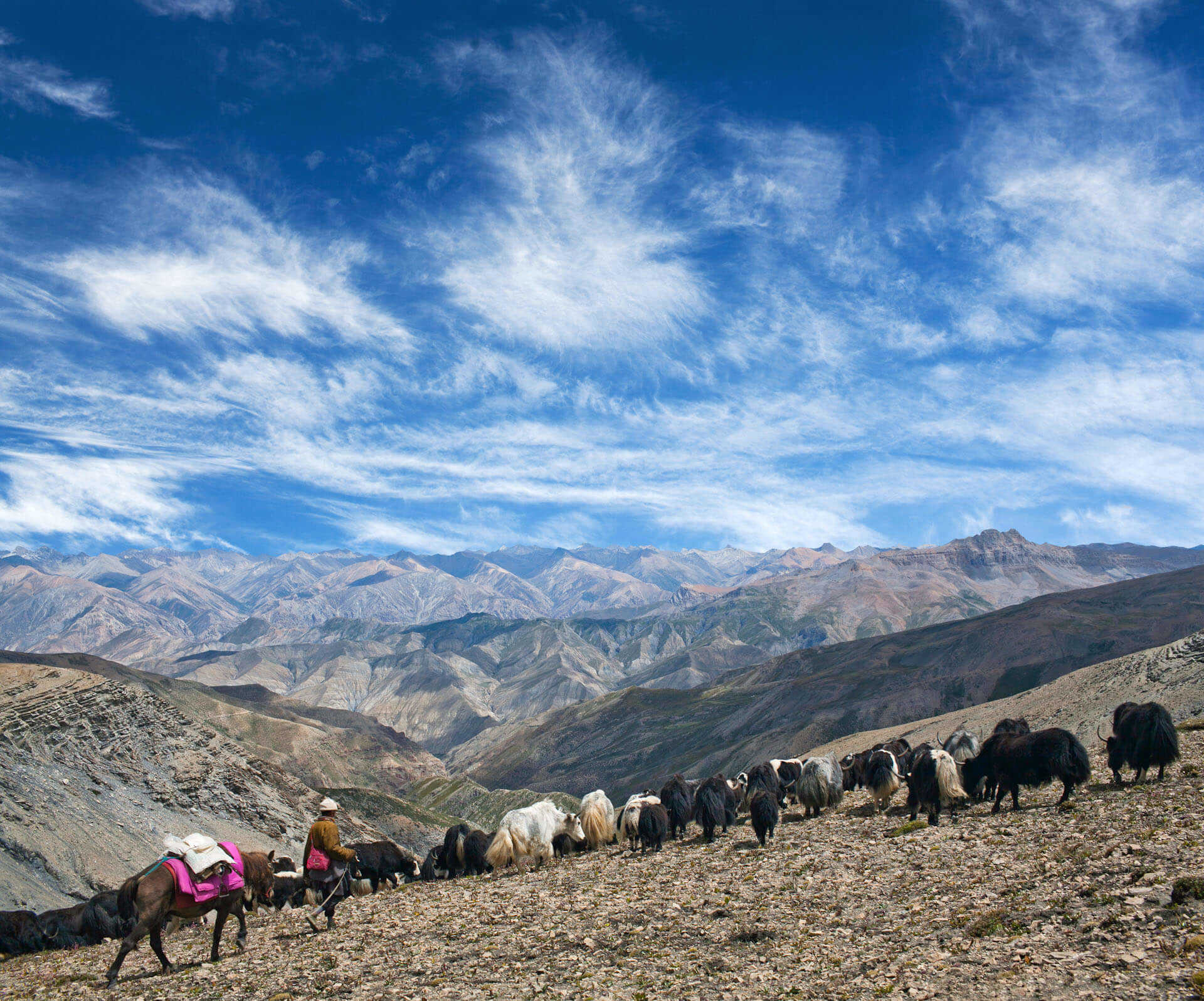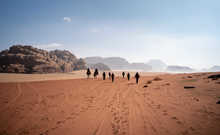Changtang Lakes to Spiti Valley
- Kandoo Trekking

Contact
our UK team

Welcome to Ladakh! On arrival in Leh, a member of our team will be waiting to collect you at the airport and transfer you to your hotel, where you will meet your guide and the other members of your group.
After breakfast, we hop in our private transfer and drive to the majestic Stok Palace, it's fortress like presence a prominent feature of Leh and it's surrounding areas. Constructed by King Tsespal Tondup Namgyal in 1825, the palace beholds a huge collection of ancient royal ornaments, Thankas and old statues. After spending time at Stok Palace, we drive to Matho village and visit the Matho monastery, built in the13th century. It is said that two famous oracles, invited from Tibet by the founder of this monastery, are said to inhabit the bodies of monks during the Matho Nagrang festival, held each year. After visiting Matho, we drive back to Leh and wander up to the Shanti Stupa view point before having a relaxed evening in Leh town.
This morning we continue acclimatising with a visit to Shey palace & Thiksey Monastery. These ancient, spiritual villages, perched on their mounds, are filled with a host of Buddhist art; including wall paintings, Thangkas, statues of different Boddhisattvas and sacred shrines, as well as a large scale Maitreya Buddha. After exploring all these hidden treasures, we return to Leh for an afternoon of trekking preparation and market exploration.
This morning we begin our journey into the mountains, stopping first at Hemis monastery, the largest monastery in Ladakh. Founded in the early 17th century, this beautifully, colourful monastery belongs to the Drukpa order. We then follow an idyllic valley, surrounded by rushing streams and fronted by long Mani stone walls, we pass through spectacular gorges and several charming villages before arriving at the remote village of Rumtse.
Today we embark on our fifteen day trek, beginning with the Kyanmar Lungpa valley, it's barren landscape flecked with pockets of green, leading us to the entrance of the Changtang plateau. We leave behind the quaint rooftops of Rumtse for the gentle slopes of the plateau, taking in the beautiful scenery and enjoying a steady start to our epic adventure.
This morning we start by ascending a long steady climb leads to the Kyamri La pass. As we step into the truly, remote high mountains keep your eyes peeled for the illusive snow leopard; these shy animals call the Changtang mountains home. We continue to walk up to Mandalchan La pass; officially arriving at the Changtang plateau. Here the scenery takes a sharp turn; lovers of wide-open spaces will be delighted as the landscape opens out and countless species of wild flowers decorate it's floor.
Beginning the day by conquering the imposing Shingbuk La pass, we are honoured with an awe inspiring view of Tsokar lake; the heart of Changtang. During the summer, many nomads migrate here from different areas to graze their herds of goats, sheep, horses and yaks in the meadows. The ensemble of animals and people bring a community feel to the depths of remote Himalaya. The Lakes of Changthang are also home to many protected species of migratory birds, so bird watchers, bring your binoculars!
Enjoy an easy trek wandering the blissful shores of Tsokar Lake, along the vast, open plateau as far as Nuruchan, where the spectacular landscape of the valley is smattered with various birds, Yaks and wild donkeys. The route then follows the gentle meandering of the deliciously green riverside, through Nuruchan village and across alpine meadows to reach the campsite for the night.
Today we cross the small pass of Horlamla at 4,900m. It is an easy ascent and once at the top we reach Rachungkaru where we find the nomadic camps of Tibetan refugees, clad in beautifully hand woven garments. Grazing yaks, sheep and pashmina goats fill the pastures surrounding the clusters of traditional cow-hair-felt tents. We can see first hand, the interesting life style of these nomadic people as we camp alongside them, learning through an exchange of cultures.
Heading through the nomadic camp we ascend steeply to Kyamayuri-La, the current high point on the trek so far, sitting tall at 5,300m. From the pass, we marvel at the wilderness stretching out before us, then easily descend to the summer pastures of another Tibetan refugee camp. We traverse around the small pass of Kartse-La, the snow blanketing it's tops, before arriving to a warm welcome at Gyama nomadic camp. We spend the evening getting to know these incredible people as we yet again camp alongside them.
Today the Yarlung Nyaula pass is a steady ascent from camp. We follow along a small stream, trending eastward across the valley floor before gaining height to the pass. From the top, the dusty oranges of the barren foreground contrast with the radiant blues of Tsomoriri in the distance, creating incredible views. It is then an easy descent to the fluttering prayer flags of Korzok Phu, before we continue downhill, tracing the river until the majestic Tsomoriri Lake stretches out before us. This evening we visit the Korzok Monastery and take a short hike around the village.
Take a day to rest and recuperate in the stunning surroundings of Tsomoriri. Located on the northern plains of Leh, this high-altitude lake is the largest in the Trans Himalayan region, covering a vast 23km, with Ladakh to the North and Tibet to the East. Fed by the snowy peaks of the Changtang Plateau, the glacial waters are a common breeding ground for a variety of birds, including; bar-headed geese, the great crested grebe and brahmin ducks.
Today, we drive along the stunning shores of Tsomoriri Lake, where the water’s colour shifts dramatically from sandy beige to bright turquoise and deep navy. As we drive across the expansive plateau, we'll pass through meadows with wildflowers peeking through the grass. Keep your eyes peeled for wildlife such as Lynx, Nayan, Bharal (Himalayan blue sheep), and the Great Tibetan sheep, which roam freely in this region. We'll start walking again from Kyangdam, a nomadic campsite, and might even spot the wild Kyang horses grazing in the area. Our walk will take us through a desert-like plateau, crossing a river before reaching our campsite at Norbu Sumdo.
After breakfast, we set off on a gentle path that leads us to the point where three valleys converge, with the Parachu River flowing east. Along the way, we’ll cross the river several times and pass through small grazing pastures before reaching our campsite at Racholangma.
Today’s hike follows the Parachu River as it winds through a landscape filled with vibrant colours, framed by towering snow-covered peaks. As we make our way toward camp, we’ll pass impressive landscape and jagged mountains that add to the awe-inspiring beauty of the surroundings.
Our journey today takes us along a narrow trail, with the towering Himalayas as our backdrop. After a small ascent to a pass, we’ll camp for the night in this stunningly beautiful location, surrounded by rugged mountain terrain.
We begin the day by crossing several rivers as we gradually ascend toward the base of Parang La. The terrain becomes more challenging as we approach the base camp, offering breath taking views of the glacier and the surrounding snow-capped peaks. We’ll camp here, beneath the shadow of the Parang Glacier, taking in the majestic landscape.
Today is the day we’ve been building up to! The trek begins with a steady ascent to the Parang La Glacier (5550m), a receding glacier with minimal thickness, though you can see streams rushing beneath it. We’ll carefully cross the glacier, enjoying panoramic views of the Spiti Valley and the surrounding snow-capped mountains. For safety, we’ll be roped together to avoid falling into crevasses, although the formation of these are extremely unlikely.
After a brief stop to take in the scenery, we’ll begin a long descent along narrow trails to the bottom of a very narrow, deep gorge. Once we’ve passed through the gorge, we’ll ascend again to Thaltak, a hilltop pasture offering incredible views of the valley below. We’ll camp here for the night, with the possibility of spotting blue sheep and ibex along the way.
The day begins with a short ascent offering fantastic views of the snow-covered peaks of Spiti. We then descend to the village of Dumla, where local farmers graze their livestock and tend to fields during the summer. From Dumla, we’ll drive to Kaza, stopping along the way to visit the historic Kie Monastery, perched high on a hill. We’ll also pass through Kiber Village, one of the highest settlements in the world, before continuing to Kaza, the capital of Spiti. Once there, we’ll have the opportunity to explore the local market and surrounding area.
Today we rest our tired feet, as we embark on the long drive to Manali. On route, we visit the remote Losar village, considered to be the first inhabited village in the Spiti Valley, located at an altitude of 4085m. We then continue driving through the spectacular scenery of different valley’s landscapes, crossing the Kunzom La and entering the Lahul valley. We reach the colourful rooftops of Manali as evening falls.
After a leisurely breakfast, today we embrace the culture of our surroundings. A visit to the Roerich gallery museum is followed by an evening walk around old Manali, taking a tour of the Hadimba temple and an exploration of the local market to buy some souvenirs.
On our final full day in India, we drive to Chandigarh, known as "the city of beauty" and capital of the Punjab state. We make our way through the winding roads of the foothills at the base of the Himalaya. On arrival in Chandigarh, if time permits, we visit the beautiful Rock Gardens and explore the city before taking an evening transfer to the railway station to catch a train to Delhi. Onboard the train we will have a delicious evening meal before arriving at Delhi fairly late and transferring to our hotel.
Transfer from hotel to airport to catch return flight.
In India, tipping is a common practice and highly appreciated. The amount you tip depends on the level of service you feel you have received.
We recommend budgeting roughly USD50 per person per week for tips. The amounts given below are not exact and are only given as an indication.
UPPER BODY
LEGS
FEET
OTHER ACCESSORIES
| From | To | Price | Availability | Book | Enquire |
|---|---|---|---|---|---|
| 13/08/2025 | 04/09/2025 | £2,599 $3,349 |
Available
|
Book now | Enquire now |
| 03/09/2025 | 25/09/2025 | £2,599 $3,349 |
Available
|
Book now | Enquire now |
| 12/08/2026 | 03/09/2026 | £2,699 $3,449 |
Available
|
Book now | Enquire now |
| 02/09/2026 | 24/09/2026 | £2,699 $3,449 |
Available
|
Book now | Enquire now |
Want to ask us a question or book a private trip? Don't hesitate to contact us!
Contact us